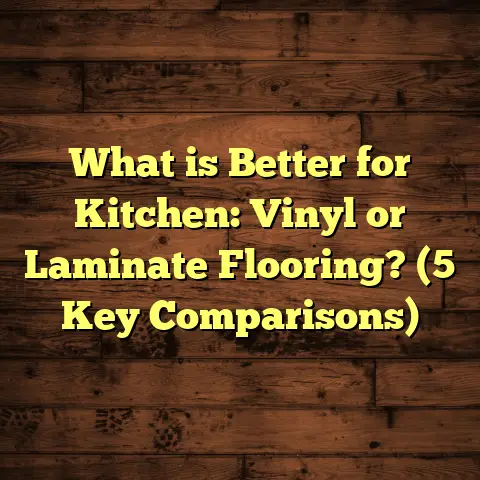What Is the Cost of Oak Flooring? (5 Factors That Impact Pricing)
The weather outside can really make me think about my floors. When it’s cold or wet, I notice how my oak flooring holds up, and when it’s warm and dry, I watch how it reacts differently. Over the years, I’ve seen firsthand how seasonal changes impact oak floors differently depending on many factors. This got me curious about the costs involved with oak flooring and what really causes prices to vary so widely. You might be thinking about oak flooring for your home or remodeling project, and you probably want to know not just the price tag but why it’s priced that way.
I’ve worked on numerous projects installing oak floors, and I’ve learned a lot that can help you make smart choices. Oak is one of the most popular hardwood flooring choices for good reasons—durability, timeless beauty, and versatility. But when it comes to budgeting, the price can feel all over the place if you don’t know what to expect.
If you’re planning a flooring project and want to avoid surprises or costly mistakes, understanding the main factors that influence oak flooring costs is crucial. In this detailed guide, I’ll walk you through 5 major factors that impact pricing, backed by real numbers, stories from my projects, and practical advice you can use right away.
What Is the Cost of Oak Flooring?
Let’s start simple: what is the cost of oak flooring? It’s the total amount you pay to buy and install oak wood floors in your home. This cost includes:
- The oak wood material itself
- Labor for installation
- Finishing or sealing
- Any additional prep work or subflooring needs
- Extras like patterns or special finishes
Oak flooring prices vary widely depending on these components. When I first started installing oak floors, I noticed clients were surprised by how much the final bill could differ even when buying the “same” wood. Why? Because not all oak is identical, and installation complexity matters.
To give you a clearer picture: materials alone can range from as low as $3 per square foot to over $15 per square foot for premium options. Add labor and finishing, and you might end up paying $8 to $20 per square foot in total.
But what drives this range? Let’s break down the 5 key factors that impact oak flooring pricing so you understand where your money goes.
1. Type of Oak: Red Oak vs. White Oak
Most people ask me early on: “Which oak should I pick?” The two main types are red oak and white oak, and they have some important differences.
Red Oak
Red oak is by far the more common choice in North America. It has a classic reddish-pink hue with visible grain patterns that many homeowners love for its warmth. It’s generally easier to find and less expensive than white oak.
- Cost: Red oak flooring material usually costs between $3 to $7 per sq ft.
- Durability: It’s sturdy but slightly less dense than white oak.
- Climate performance: Red oak is more prone to moisture damage, so in humid or damp areas it might warp or cup more easily.
I remember installing red oak floors in a suburban home in Ohio where winters were harsh but humidity was moderate. The floors held up well with regular maintenance.
White Oak
White oak has gained popularity recently due to its durability and moisture resistance. It has a subtle grayish or olive tone that fits well with modern or rustic styles.
- Cost: White oak is pricier—expect about $5 to $10 per sq ft for material.
- Durability: Denser and harder than red oak, making it better for high traffic.
- Climate performance: More stable in humid environments.
In a coastal home renovation I worked on near Seattle, white oak was recommended because red oak would risk swelling in the damp climate. They paid around 30% more upfront but avoided costly repairs later.
Which Should You Choose?
Ask yourself:
- Is your climate humid or dry?
- Do you prefer warm reddish tones or cooler grays?
- What’s your budget?
If you want long-term durability and live in a moist area, white oak is worth the extra cost. If your climate is stable and you want a classic look, red oak is a solid choice.
2. Solid Oak vs. Engineered Oak Flooring
Another big question is whether to pick solid or engineered oak flooring.
Solid Oak Flooring
Solid oak planks are milled from a single piece of wood—usually about ¾ inch thick. You can sand and refinish them multiple times over decades.
- Cost: Material costs range from $5 to $12 per sq ft, depending on grade.
- Installation: Usually nailed or stapled down onto wooden subfloors.
- Longevity: Can last 50+ years with proper care.
- Climate sensitivity: Expands and contracts with humidity changes; not ideal for basements or concrete slabs without special prep.
I’ve installed solid oak floors in many traditional homes where longevity was a priority. One client had their floor sanded and refinished five times over 30 years!
Engineered Oak Flooring
Engineered wood has a thin layer of real oak on top bonded to plywood or high-density fiberboard underneath. This multi-layer construction makes it more dimensionally stable.
- Cost: Usually cheaper upfront—about $4 to $9 per sq ft for materials.
- Installation: Can be glued down, floated, or stapled.
- Longevity: Can be sanded only 1–3 times depending on wear layer thickness.
- Climate sensitivity: Better for basements or areas with moisture fluctuations.
In homes near lakes or in basements I’ve worked on, engineered oak prevented warping issues common with solid wood floors.
Which Fits Your Home Best?
Think about:
- Is this a main-level room with wood subfloor?
- Do you want to refinish multiple times?
- Is moisture a concern (basement, kitchen)?
If yes to refinishing and stable subfloor—solid oak performs beautifully. Otherwise, engineered offers flexibility with less risk of damage.
3. Grade of Oak Flooring
Oak floors come in different grades which affect appearance and price.
Select Grade
- Minimal knots
- Consistent color and grain
- Smooth finish
- Highest cost (about 20–30% more than lower grades)
This grade suits formal rooms or modern designs where uniformity matters.
Character Grade
- Includes small knots, mineral streaks
- Varied color tones add natural beauty
- Mid-priced option
Many clients prefer this grade because it adds warmth without looking too “perfect.”
Rustic Grade
- Many knots and imperfections
- Wide color variation
- Most affordable option
Rustic grade floors are great for casual spaces like cabins or family rooms where character is desired.
For example, one client wanted a farmhouse look on a budget. We chose rustic red oak with lots of knots. The floor was stunning and cost 25% less than select grade.
4. Installation Costs & Method
Installation costs can vary dramatically depending on method and complexity.
Basic Installation Types
- Nail-down: Common for solid wood; requires wooden subfloor
- Glue-down: Used mostly for engineered floors on concrete slabs
- Floating: Click-lock systems installed over underlayment; often DIY-friendly
Labor Costs
On average:
- Simple straight plank installations cost $3 to $5 per sq ft
- Complex patterns (herringbone, parquet) can go up to $8+ per sq ft
I once installed a herringbone white oak floor that took twice as long due to pattern complexity — labor costs nearly doubled compared to straight lay floors.
Subfloor Preparation
If your subfloor isn’t flat or has moisture issues, expect extra costs:
- Leveling floors can add $1–$3 per sq ft
- Moisture barriers may add another $0.50–$1 per sq ft
In one basement renovation I managed, prep work added nearly $2,000 to the budget but was necessary to protect the new floor.
DIY vs Professional Installation
DIY installation can save money on labor but requires skill and tools. Floating engineered floors are easiest for DIYers; solid oak nail-down methods usually need pros.
Avoid cutting corners here—poor installation leads to squeaks, gaps, or buckling down the road.
5. Finishing and Staining
Oak floors can come unfinished (raw wood) or prefinished (factory sealed).
Unfinished Oak Floors
You choose stain color and finish type on-site. This gives full customization but adds:
- Staining and finishing labor costs ($2–$4 per sq ft)
- Time delays due to drying/curing
I helped a family pick an unusual dark walnut stain on unfinished white oak—took extra time but matched their décor perfectly.
Prefinished Oak Floors
These come sealed with durable factory-applied finishes (often polyurethane). Advantages:
- Faster installation since no onsite finishing needed
- Durable factory finish often superior to DIY
- Slightly higher upfront material cost
Many clients prefer prefinished for convenience and less mess during installation.
Additional Factors That Can Impact Cost
Beyond these five main points, other factors also influence oak flooring costs:
Geographic Location
Labor rates vary widely by region. For example:
- Urban centers like New York or San Francisco have higher labor costs ($6–$10 per sq ft)
- Smaller towns may see rates closer to $3–$5 per sq ft
Using tools like FloorTally helps get local cost estimates based on real data.
Floor Size & Shape
Large open areas are cheaper per square foot than small rooms with many corners because installers work faster without cutting around obstacles.
Rooms with odd shapes or many doorways add labor time.
Additional Materials
Underlayments, trims (quarter rounds), transition strips, stair nosing—all add to final costs.
Real-Life Case Studies From My Projects
To give you even more insight, here are some detailed examples from recent projects:
Case Study 1: Suburban Family Home – Red Oak Solid Flooring
Location: Columbus, Ohio
Size: 1,200 sq ft
Grade: Select Red Oak
Installation: Nail-down
Finish: Prefinished factory finish
Material Cost: $5 per sq ft × 1,200 = $6,000
Installation Cost: $4 per sq ft × 1,200 = $4,800
Additional Costs: Moisture barrier + trim = $800
Total Cost: ~$11,600
Outcome: The family loved the warm tones and durability. Floors held up well through four kids and pets over five years with minimal wear.
Case Study 2: Coastal Condo – Engineered White Oak Flooring
Location: Seattle, WA
Size: 900 sq ft
Grade: Character Grade White Oak
Installation: Glue-down
Finish: Unfinished with custom stain
Material Cost: $7 per sq ft × 900 = $6,300
Installation Cost: $5 per sq ft × 900 = $4,500
Finishing Cost: $3 per sq ft × 900 = $2,700
Additional Costs: Subfloor prep = $1,000
Total Cost: ~$14,500
Outcome: The engineered floor resisted moisture well over two years despite rainy winters. Client was happy with custom darker finish.
Case Study 3: Rustic Cabin – Rustic Grade Red Oak
Location: Upstate New York
Size: 800 sq ft
Grade: Rustic Red Oak
Installation: Nail-down
Finish: Unfinished with natural oil finish
Material Cost: $3.50 per sq ft × 800 = $2,800
Installation Cost: $3.50 per sq ft × 800 = $2,800
Finishing Cost: $2 per sq ft × 800 = $1,600
Total Cost: ~$7,200
Outcome: Floor matched cabin aesthetic perfectly; low cost allowed budget for other renovations.
Tips From My Years Installing Oak Floors
If you want my advice on saving money without sacrificing quality:
- Choose engineered wood if moisture is an issue. It saves repair headaches later.
- Pick character grade for charm at lower cost. Knots hide scratches well.
- Keep installation simple: avoid complicated patterns unless budget allows.
- Consider prefinished floors if you want fast installation.
- Get multiple quotes and use tools like FloorTally for local cost estimates.
- Plan subfloor prep early: better to invest upfront than fix problems later.
- Don’t skimp on professional installation unless you’re very confident DIYer.
Beyond Cost: Why I Love Working With Oak Floors
I’ve installed hundreds of floors over my career—oak remains my favorite material because it’s forgiving yet beautiful.
I’ve seen homes transformed by a new solid white oak floor that feels warm underfoot and looks stunning year after year.
Weather changes don’t scare these floors when chosen correctly—engineered options thrive in damp basements; solid red oak shines in dry living rooms.
The key is matching your specific needs to the right type of oak and installation method so your floor lasts decades without stress.
How To Get Started With Your Oak Flooring Project Today
If you’re seriously considering oak floors now:
- Measure your space carefully — get square footage accurate within 5%.
- Decide your climate challenges — do you have humidity swings?
- Choose between red vs white oak based on style & durability preferences.
- Pick solid vs engineered based on subfloor & room use.
- Select grade balancing appearance & budget.
- Decide if you want unfinished (custom stain) or prefinished.
- Find local contractors & get quotes.
- Use online calculators like FloorTally to compare estimates.
- Check for extra costs like subfloor prep & finishing.
- Plan timeline & budget accordingly—oak floors take weeks from start to finish.
Final Thoughts
Oak flooring is an investment that pays off in beauty and durability if done right.
Understanding what impacts cost lets you plan better and avoid surprises.
By focusing on these five factors — type of oak, solid vs engineered, grade, installation method, and finishing — you’ll get a floor that fits your home perfectly within your budget.
And if you want personalized advice tailored to your project specifics, just ask me! I’m always happy to share tips from my hands-on experience installing hundreds of oak floors across varying climates and budgets.
Remember—the right oak floor isn’t just about price; it’s about value that lasts for decades under your feet.





